The Antiplanner comments on another ridiculous streetcar plan, this one for Oklahoma City. Minneapolis reporter Marlys Harris responds, however, that streetcars “are adorable. Who wouldn’t want to ride a one-car choo-choo rather than a big, smelly bus?”
Harris is supposed to be an “an investigative reporter and editor with specialties in consumer protection and finance.” Perhaps someone should introduce her to the reality of government finance, which is that the more wasteful a project is, the more people who benefit from that waste will lobby to promote it. It might not hurt to let her know that streetcars don’t now and never did go “choo choo.”

It was a difficult task for men who to overcome ED when there were no oral medicines. prescription de viagra canada This article takes a look at all click here to find out more viagra 100mg sales three of these sides. Patients under treatment for cost viagra any other health condition then he must avoid using this medicine. Water helps Tadalafil Soft gel Capsule to vardenafil vs viagra dissolve faster and show faster effects.
More specifically, except where cities offer streetcar rides for free (Tacoma and, until last September 1, Portland), buses actually attract more passenger miles of riders per vehicle mile than streetcars. The idea that streetcars “generate more economic activity” than buses is merely a myth used to cover up government waste.
It seems strange that someone who is supposed to be an expert in consumer protection can’t carry that over to taxpayer protection. A streetcar line costs roughly 50 times as much to build as starting a similar bus line. The streetcars cost twice as much to operate and, in the long run, many times more to maintain. Despite her training as an urban planner, if a consumer asked Harris, “should I get the expensive but adorable version or the version that costs only 2 percent as much?” I sincerely doubt she advise adorability over economy.








The Antiplanner comments on another ridiculous streetcar plan, this one for Oklahoma City. Minneapolis reporter Marlys Harris responds, however, that streetcars “are adorable. Who wouldn’t want to ride a one-car choo-choo rather than a big, smelly bus?”
Isn’t there someone in Oklahoma City that is willing to say nice things about the proposed streetcar? Why does someone from Minnesota have to promote it? Are they going to run the streetcar along I-35 from Oklahoma City to Minneapolis?
And finally, has Marlys Harris ever heard of a trolleybus? Perhaps not.
Adorability will soon replace “livability” as the basis for evaluating New Starts proposals.
MJ wrote:
Adorability will soon replace “livability” as the basis for evaluating New Starts proposals.
Best thing I have read today.
On my time, I do find streetcars, trams and trolleys to be adorable and lovable – and very cool.
But that does not in any way make them appropriate projects to spend taxpayer dollars on.
Why don’t cities invest in buses that
(a) have high adorability (perhaps licensing Hello Kitty decor from Sanrio)
(b) have electric whistles to go choo-choo, perhaps emitting puffy white clouds of water vapor from a little reservoir
(c) drive on lanes where metallic black stripes have been painted on the asphalt one bus-width apart?
I’m serious.
To amplify the seriousness of my last comment: I don’t wish to scoff at adorability or pretend it doesn’t exist. Adorability is real and has powerful consequences in a free market.
However the Antiplanner asks “Adorability or economy?” as if they were in opposition. Why can’t we have both?
The Mini Cooper would be an example of a vehicle that has its roots in a strong desire for economy, but that is considered by many people to be highly adorable.
@ Zilliacus “I do find streetcars, trams and trolleys to be adorable and lovable – and very cool.”
What about very dangerous..?! They don’t call it WhamBamTram for nothin’.
The most important to thing to remember, when reading a media statement or planner-prepared manifesto about any smart-growth style project, is that planners, their backers, and their media lackeys are all liars. That simplifies the level of analysis we must undertake and waste time on when viewing their plans. If we already know them to be liars, we don’t need to spend hundreds of hours poring over their fabricated data and papers.
Dave Brough wrote:
What about very dangerous..?! They don’t call it WhamBamTram for nothin’.
Houston?
I don’t believe that streetcars are inherently dangerous – but – that presumes that other users of the streets on which they run are fully aware of their limitations and the (unique) limitations and dangers associated with electric street railway operations.
Streetcars and rubber-tire traffic get along pretty well in cities that have had long-established systems, which was (and is) not the case in Houston.
But just because I like streetcars and trams and trolleys on my time does not mean I favor the construction of new systems, because I do not. As a former colleague liked to put it when talking about streetcars (and I feel the same way), “I keep it on the reservation.”
Partick Condon claims cities could reduce their greenhouse gas emissions by 50 percent or more by linking streetcars and higher-density land use
http://www.sala.ubc.ca/people/faculty/patrick-condon
Partick Condon claims cities could reduce their greenhouse gas emissions by 50 percent or more by linking streetcars and higher-density land use
Yeah, I think I saw a presentation of that concept one time…
I don’t know the accuracy of this but the rumor among some rail fans up in the twin towns is the routing announced by MPLStown has some technical issues that will be very expensive to overcome.